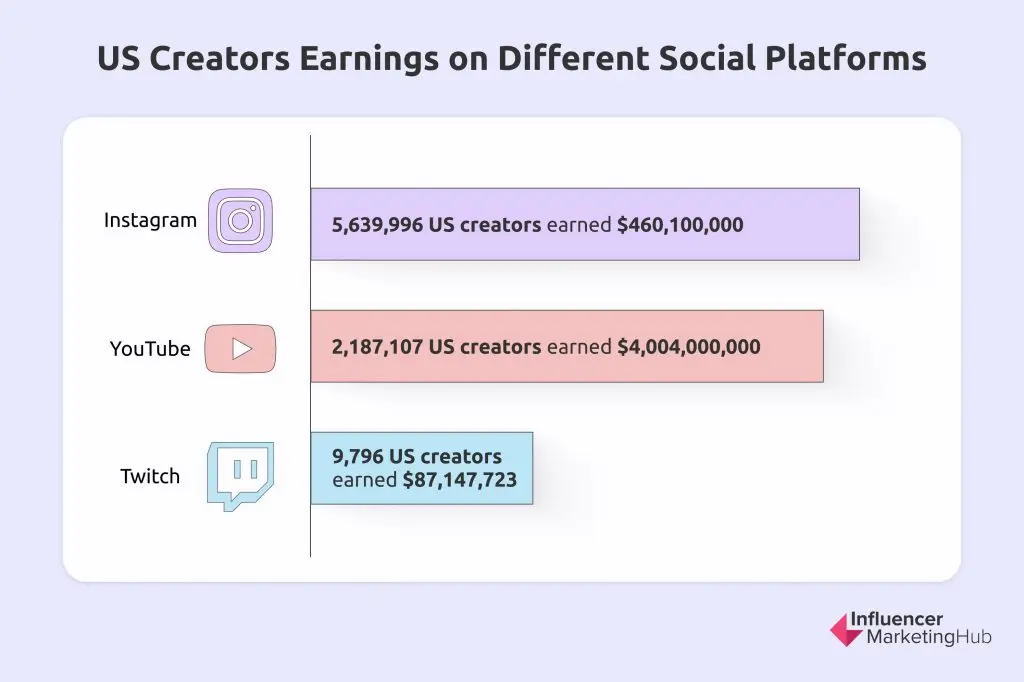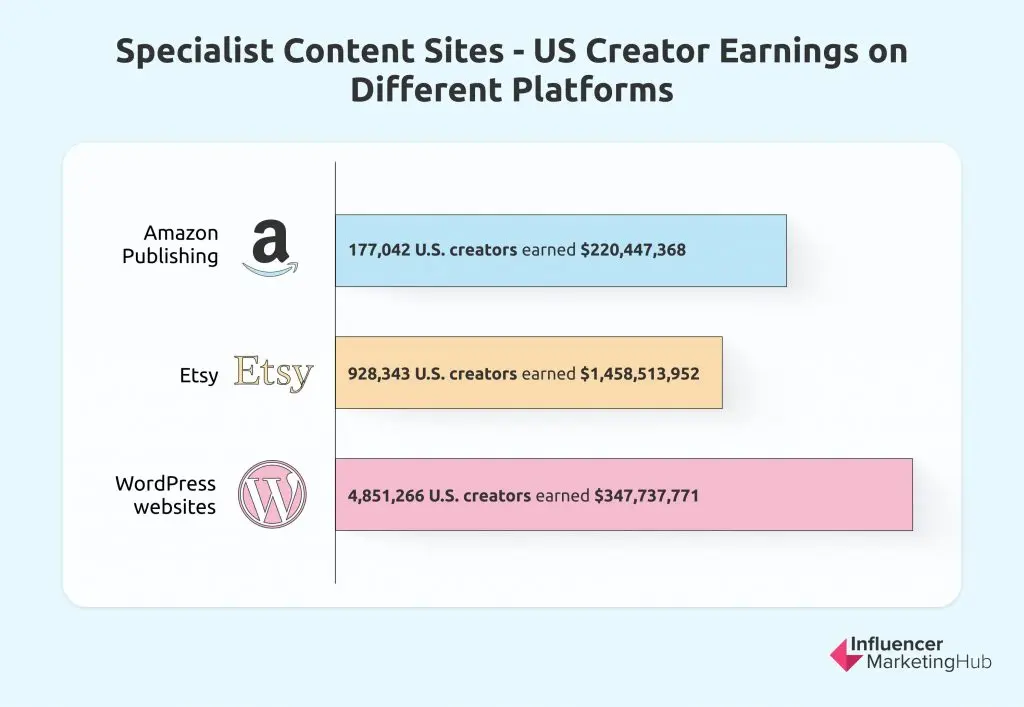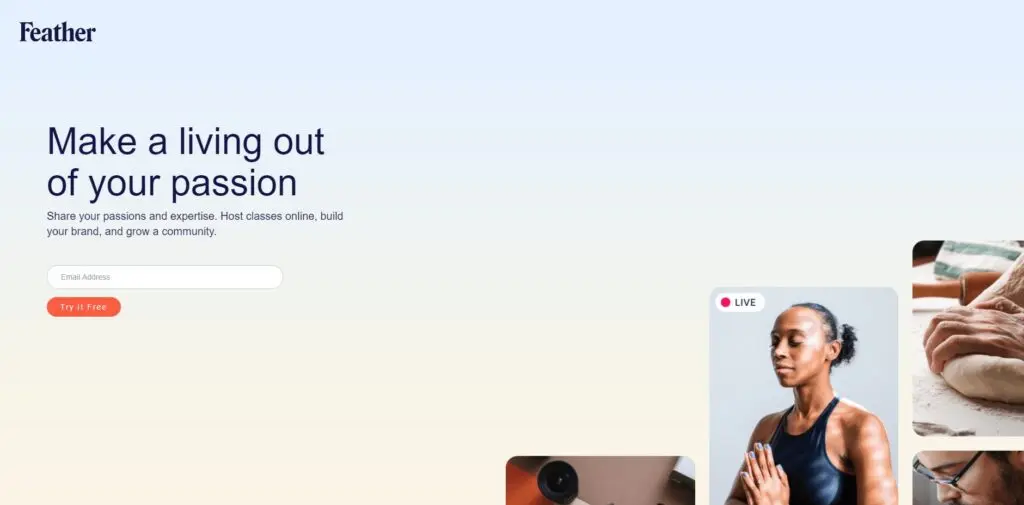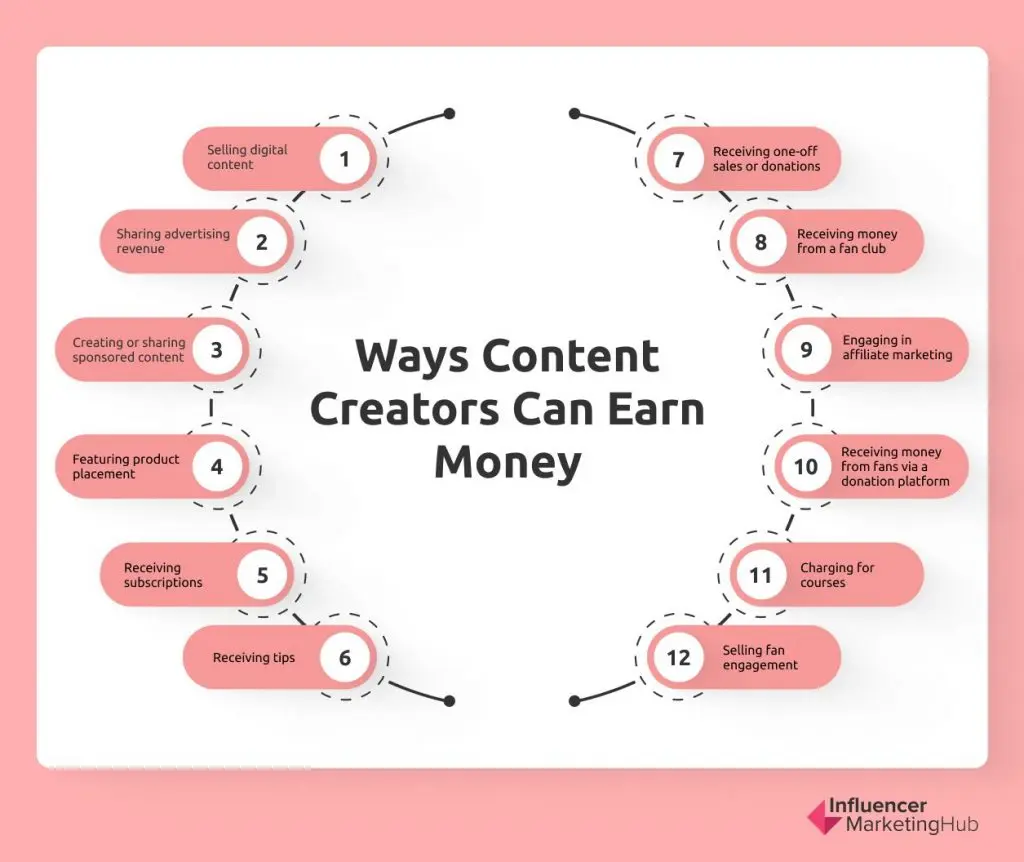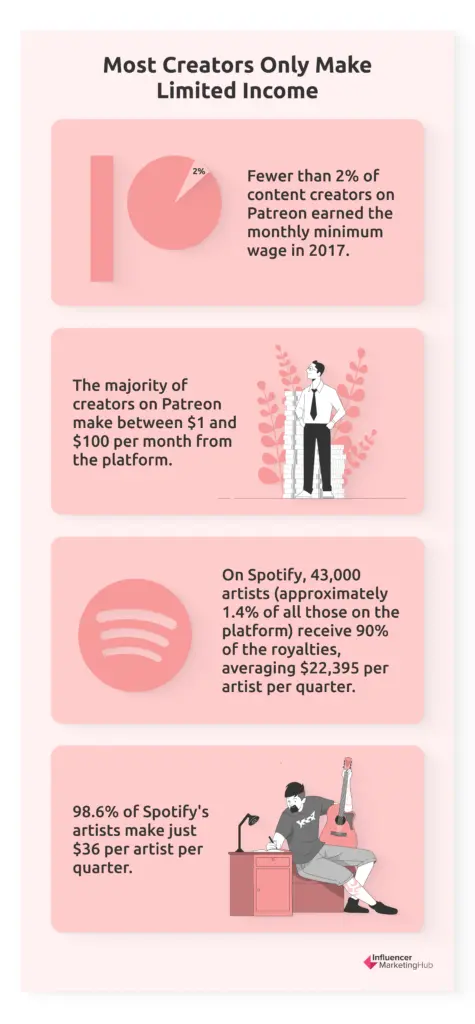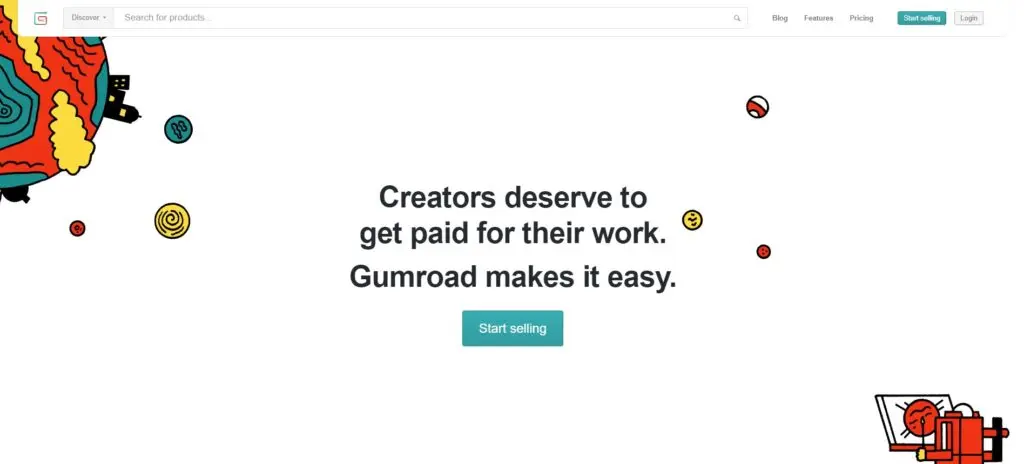One of the most noticeable changes in society over the last decade has been the advent of the creator economy. Sure, there have been creators for many years engaging in their passions. Yet, few people were able to make a living from their creativity – just a few talented and popular enough to make a living as professional writers, artists, actors, and the like. However, nowadays, there are many more ways for creative people to make a living, to a large extent thanks to opportunities offered by social media and Web 2.0.
As we wrote in What is the Creator Economy, the internet has decentralized the media. We have found many different types of content we love, and it is no longer all owned by the traditional big media companies. Indeed, much of it is written, photographed, filmed, or otherwise created by ordinary people like ourselves. Alongside this, new payment methods and ways of earning money have been developed that make the whole process more manageable and viable.
The arrival of COVID-19 in early 2020 threatened to derail this process but instead has strengthened it. A combination of lockdowns and worsened unemployment has sent creators searching for new ways to earn a living while at the same time giving people more time to hunt for content, looking for ways to fill in their increased leisure hours. The creator economy is a subset of the passion economy. This is because creators are usually people who can now earn an income from doing something they feel passionate about. It may have just begun as a hobby, and it would probably have remained that in the past. But nowadays, many passionate creators have found a way to make their hobby viable enough to earn at least a steady income. Why spend your days grafting in a minimum wage dead-end job when you can earn a good living from doing something you love?
State of the Creator Economy:
- How Big is the Creator Economy?
- Evolution of the Creator Economy
- The Creator Economy Finds New Ways to Make People Productive
- Main Types of Creator Content
- Popular Content Creation Tools
- The Link Between Creators and Influencer Marketing
- Ways Content Creators Can Earn Money
- Don't Underestimate the Difficulty of Earning an Income as a Creator
- The Importance of Memberships as Validation
- The Role of Non-Fungible Tokens in the Creator Economy
- The Absence of a Middle Class of Creators
- Frequently Asked Questions
How Big is the Creator Economy?


More than 50 million people worldwide consider themselves to be creators. Of these, 46.7 million think themselves to be amateurs, with two million-plus considering themselves to be professional creators, earning enough from their passion to consider it their full-time income.
Notably, half the professional creators (one million approximately) earn their money on YouTube, with 25% (500,000) making their money via Instagram (predominantly as influencers). Another sizable platform for professional creators is Twitch, with 300,000 professional streamers. The remaining 200,000 (approximately) earn their creator income from other sources, such as acting, music, podcasting, blogs, writing, and illustrating.
Many amateur creators still make some income thanks to their creativity, just it isn't enough for them to give up their day job. The largest group here (30 million) makes their money as Instagram influencers, although there is also a sizable number of YouTubers making some money (12 million).
Evolution of the Creator Economy
You couldn't have creators if you didn't have platforms on which they could create. These include both social channels and specialist content channels.
Improved technology has much helped the development of the creator economy. Many creators needed to spend large sums on expensive equipment to carry out their passion in the past. For instance, if you wanted to take quality photographs, you once needed a high-end camera, often with multiple lenses. Only a few dedicated video enthusiasts owned specialized video cameras. Nowadays, anybody with a smartphone has acceptable still and video cameras in their pocket. While most writers still need a laptop, or at a pinch, a tablet, these are commonplace and relatively cheap now.
The development of the gig economy has also encouraged the creator economy. In the past, most people received income predominantly from salaries or wages. However, now many people earn income from short-term work arrangements, including freelancers, consultants, temps, and independent contractors. The income earned by many creators is just an extension of this. Technology has lowered the entry barriers to the gig economy, making it available to virtually everybody with a smartphone or laptop.
MBO Partners has classified participants in the gig and creator economies are independents and splits them into:
- Full-time independents – people who work more than 15 hours per week doing their chosen activity, who don't plan on altering it for the foreseeable future
- Part-time independents – those who regularly work for less than 15 hours per week at their chosen activity as a way to supplement their other income
- Occasional independents – those who work at their chosen activity sporadically but do so at least once a month.
Initially, the creator economy mainly consisted of people with particular skills sharing them online, often by teaching them on a platform like Teachable. However, with the development of creative social media, such as TikTok and YouTube, new stars have eventuated despite lacking existing creative skills, such as previous video making expertise.
You can still make good money from teaching your skills online, however. Teachable released data relating to the creators on its platform in 2020. They observed that creators earned a total of $456.7 million. They launched 183,744 new courses and 17,686 coaching products in that year. The average price of a coaching product was $167, and the average one-time payment for a course was $120. Teachable hit the milestone of having $1 billion in creator sales in 2020.
Social Media's Role in the Creator Economy
The development of social media has been pivotal to the rise of the creator economy. The key to success as a creator is not so much creating content as it is distribution. And social media has developed into a powerful method of sharing and distributing the content that creators produce. Above anything else, creators need an engaged community of fans, and social media helps provide this.
According to Investopedia, "social media is computer-based technology that facilitates the sharing of ideas, thoughts, and information through the building of virtual networks and communities." While low bandwidths and limited internet capabilities meant that social media was initially text-based, it wasn't long before people regularly began to share images (and specialist image-sharing networks like Instagram and Pinterest thrived). Nowadays, most social networks encourage sharing videos too. Although the developers of YouTube probably didn't think of their platform as a social network initially, it is very much so now. "Social media may take the form of a variety of tech-enabled activities. These activities include photo sharing, blogging, social gaming, social networks, video sharing, business networks, virtual worlds, reviews and much more."
While much of the creativity doesn't occur directly on social sites and video channels, they provide a comparatively cheap way to market your creativity. In some cases, such as popular channels on YouTube and live streaming networks like Twitch, social media doubles as the platform hosting the creators. As we have seen, a sizable number of creators have become influencers, particularly on Instagram and YouTube.
Robert Shapiro with Siddhartha Aneja wrote Taking Root: The Growth of America's New Creative Economy for re:create, which analyzed the millions of Americans who produced and disseminated creative content on the internet in 2017. They observed that 2,187,107 U.S. creators earned $4,004,000,000 on YouTube that year, 5,639,996 U.S. creators earned $460,100,000 on Instagram, and 9,796 U.S. creators earned $87,147,723 on Twitch. As all three social network statistics were up considerably on the previous year's figures, current figures are likely still higher
As well as creators sharing content directly on sites like YouTube, Instagram, and Twitch, they regularly share links over other social sites like Facebook, Pinterest, Reddit, and Twitter.
Specialist Content Sites
Specialist content sites also give a place for talented creators to share their work. Musicians create tunes and place them on Spotify and iTunes. In the past, you generally had to be signed with a major music company if you wanted people to buy your music. Now you can create a track yourself and become an independent distributor.
Anybody can write a book and publish it via Amazon. Sure, you need to market it well if you want to make high sales levels, but it is possible to publish your own fiction or nonfiction, with no need for an agent.
Another way that writers can earn money is through a blog, either their own, where they can earn income from advertising or by charging memberships or as a contract writer for somebody else's site. Another option is to write on a more general-purpose blog site, like Medium.
As we have previously observed, many creators make money on Teachable and other course creation platforms.
Shapiro and Aneja also analyzed some specialist content sites in their review of creative Americans in 2017. 177,042 U.S. creators earned $220,447,368 on Amazon Publishing, 928,343 earned $1,458,513,952 on Etsy, and 4,851,266 earned $347,737,771 on WordPress blogs and websites.
The Creator Economy Finds New Ways to Make People Productive
Before the advent of the creator economy, many of today's creators would have been unemployed or at very least engaged in comparatively low-level employment. All these people have skills, but previously they would have been unable to monetize their passions.
Now people can unlock their creative potential and give it value. People who may have been discouraged from engaging in creative endeavors have the potential to advance their skills and find a market for their activities. Experts can make a living by teaching their skills on a site like Teachable rather than having to organize in-person classes as they would have done previously. Developers can use programs like GitHub Sponsors to receive money directly from the community. Everyday people can make and share videos without being employed by a film or television company. There are whole new types of content like podcasts that have attracted an enthused audience.
Main Types of Creator Content
Creator content has changed in line with the development of relevant tools and platforms. For example, video creation was initially limited to professional film and television makers, making a small number of videos, usually for mass audiences. A few dedicated amateurs made films and videos using relatively expensive specialized equipment. With the founding of YouTube in 2005, amateur filmmakers had a site where they could upload and share videos, and phone makers began to include video cameras in their smartphones. Initially, YouTube still had limited use because of slow internet bandwidth. Over time, higher-speed Internet and cheaper smartphones have meant that most people now have access to a video camera. Many existing social media apps have added and encouraged video, and new specialist video sharing sites, like TikTok, have become exceptionally popular.
There are many different types of creator content, even if you restrict your analysis to digital content. A selection of creator content types include:
- Infographics
- Memes
- Videos/vlogs
- Live video
- How-To guides
- Courses
- Photos, illustrations, and other images
- Newsletters
- Blog posts
- Apps
- eBooks
- Comics / cartoons
- Podcasts
- Slideshows
- Games
- Tools
- Webinars
- Literary works
- Wikis
Popular Content Creation Tools
Fitness
 |
Animoto | https://animoto.com | Create video content |
 |
Salut | https://www.joinsalut.com | Create livestream content, monetize community |
 |
Magisto | https://www.magisto.com | Create video content |
 |
Playbook | https://playbookapp.io | Create video content, manage community, monetize community, grow community |
 |
Strydal | https://www.strydal.com/ | Create livestream content, manage community, monetize community, grow community |
 |
Superset | https://www.supersetapp.com/ | Manage community, monetize community, grow community |
 |
My PT Hub | https://www.mypthub.net/ | Creates livestream content, manage community, monetize community |
Podcasters
 |
Acast | https://www.acast.com/en | Create audio content, manage community, monetize community, grow community |
 |
Anchor | https://anchor.fm | Create audio content, manage community, monetize community |
 |
Buzzsprout | https://www.buzzsprout.com | Create audio content, manage community, grow community |
 |
Capiche FM | https://capiche.fm | Create audio content live |
 |
Castbox | https://castbox.fm/ | Create audio content, manage community, monetize community |
 |
GetVokl | https://about.getvokl.com/how-to-broadcast | Create video content, manage community, grow community |
 |
Glow | https://www.glow.fm | Create audio content, manage community, monetize community |
 |
Podbean | https://www.podbean.com | Create audio content, manage community, monetize community, grow community |
 |
Squadcast | https://squadcast.fm | Create audio content |
 |
Supercast | https://www.supercast.com | Manage community, monetize community |
 |
Vurbl | https://vurbl.com | Create audio content |
 |
Red Circle | https://www.redcircle.com/ | Monetize community, grow community |
 |
Megaphone | https://www.megaphone.fm | Create audio, monetize community |
Writers
 |
Ghost | https://ghost.org/features/ | Create email and newsletters, monetize community, manage community |
| Letterdrop | https://letterdrop.co/ | Create newsletters or blog, manage community, monetize community, grow community | |
 |
Medium | https://medium.com | Create written content, monetize community |
 |
Revue | https://www.getrevue.co/ | Create editorial/newsletters, manage community, monetize community, grow community |
 |
Substack | https://substack.com/ | Create blog/newsletter content, monetize community, manage community |
 |
Steady | https://steadyhq.com/en | Create newsletters/posts, manage community, monetize community |
 |
Tales | https://taleswriter.com | Create a book, monetize community |
 |
Wattpad | https://www.wattpad.com | Create a book, monetize community |
Gaming
 |
Athenascope | https://athenascope.com | Create highlights |
 |
Discord | https://discord.com/ | Manage community |
 |
Epic Games | https://www.epicgames.com | Monetize community |
| GamerzClass | https://gamerzclass.com/ | Create masterclass, monetize community | |
 |
Hiberworld | https://hiberworld.com/ | Create game |
 |
Lowkey | https://api.lowkey.gg | Capture gaming highlights |
 |
Maestro | https://www.maestro.io | Create stream and game highlights, manage community, monetize community |
 |
Manticore Games | https://www.manticoregames.com/ | Create game, monetize community, grow community |
 |
Replai | https://www.replai.io/ | Create highlights |
 |
Roblox | https://corp.roblox.com/technology/ | Create games, monetize community, grow community |
 |
Unity | https://unity.com/ | Create game |
 |
1v1Me | https://www.1v1me.com | Monetize community |
 |
Combo | https://clips.joincombo.com | Grow community |
 |
E-pal | https://www.epal.gg | Monetize community |
 |
Metafy | https://metafy.gg | Monetize community |
 |
Nexus | https://www.nexus.gg | Create channel, monetize community |
Livestreaming
 |
Streamloots | https://www.streamloots.com/ | Create livestream, monetize community |
 |
Loots | https://new.loots.com/ | Monetize community |
 |
Twitch | https://www.twitch.tv | Create livestream, monetize community, manage community, grow community |
 |
Mandolin | https://www.mandolin.com/ | Create livestream, monetize community, grow community |
| Streamclub | https://www.stream.club/ | Create livestream, manage community, monetize community | |
 |
Uscreen | https://www.uscreen.tv | Create livestream, manage community, monetize community |
 |
Stream Elements | https://streamelements.com/ | Create livestream, manage community, monetize community, grow community |
 |
Crowdcast | https://www.crowdcast.io/ | Create livestream, management community, grow community |
| Streamlabs | https://streamlabs.com/ | Create livestream, manage community, grow community | |
 |
Lightstream | https://lightstream.gg/ | Create livestream |
 |
Onyx Servers | https://www.onyxservers.com | Create livestream |
 |
Restream | https://restream.io/ | Create livestream |
| Special TV | https://www.specialproject.io/ | Create livestream, monetize community | |
 |
Stage 10 | https://stageten.tv/ | Create livestream, grow community |
Musicians
 |
Abletone Live 11 | https://www.ableton.com | Create music |
 |
Sonix | https://sonix.ai | Create music files |
 |
Stageit | https://www.stageit.com | Create and host online concerts, monetize community |
 |
Beatstarts | https://www.beatstars.com/ | Create digital music, monetize community, grow community |
 |
Createsafe | https://createsafe.io/ | Create music business, manage community, monetize community |
| Mastered | https://emastered.com/en | Create remastered music | |
 |
FL Studio | https://www.image-line.com | Create music |
 |
Garageband | https://www.apple.com/mac/garageband/ | Create music |
 |
Kobalt Music | https://www.kobaltmusic.com/ | Create music stream, monetize community |
 |
Snapjam | https://www.snapjam.co | Create music |
 |
Splice | https://splice.com | Create music |
 |
Stem | https://stem.is/ | Create music, manage community, monetize community |
 |
Landr | https://www.landr.com/ | Create music, monetize community |
Course Creators
 |
Airsubs | https://airsubs.com | Create classes, manage community, monetize community, grow community |
 |
Avocado | https://www.avocadoaudio.com | Create course, manage community, monetize community |
 |
Heights | https://www.heightsplatform.com | Create course, manage community, monetize community, grow community |
 |
Kajabi | https://kajabi.com | Create course, manage community, monetize community |
 |
Podia | https://www.podia.com | Create course, manage community, monetize community |
 |
SamCart | https://www.samcart.com | Manage community, monetize community |
 |
Skillshare | https://www.skillshare.com | Create course |
 |
Teachable | https://teachable.com | Create course, manage community, monetize community |
 |
Thinkific | https://www.thinkific.com | Create course, manage community, monetize community |
| Xperiencify | https://xperiencify.com | Create course | |
 |
Virtually | https://tryvirtually.com | Create course, manage community, monetize community |
 |
Slip | https://www.slip.so | Create course, manage community, monetize community |
Influencers
 |
Cameo | https://www.cameo.com | Create exclusive content, monetize community |
 |
Memmo | https://memmo.me | Create exclusive content, monetize community |
 |
iFans | https://www.ifans.com | Create exclusive content, monetize community |
 |
Instasize | https://instasize.com | Create photos/videos |
| Later | https://later.com | Manage community, grow community | |
 |
Lightricks | https://www.lightricks.com | Create photos/videos |
| Looped | https://loopedlive.com | Create exclusive content, monetize community | |
 |
My Fanpark | https://myfanpark.com | Create exclusive content, monetize community |
 |
Tipsnaps | https://tipsnaps.com | Create exclusive content, monetize community |
All Content Creators - Own Community
 |
Circle | https://circle.so | Create community, manage community, grow community |
| Creator Metrics | https://creatormetrics.io | Manage community, grow community | |
 |
Disciple | https://www.disciplemedia.com | Create community, manage community, monetize community, grow community |
 |
Jemi | https://jemi.app/ | Create community, manage community, monetize community, grow community |
 |
Ko-fi | https://ko-fi.com | Create community, monetize community, grow community |
 |
Patreon | http://www.patreon.com/ | Create community, manage community, monetize community, grow community |
 |
Buy me a Coffee | https://www.buymeacoffee.com | Create community, manage community, monetize community, grow community |
 |
Zebra | https://zebraiq.com | Create community, monetize community |
 |
Vibley | https://www.vibely.io/ | Create community, manage community, monetize community |
 |
Creator Stack | https://creatorstack.com | Create community, manage community, monetize community |
 |
Mighty Networks | https://www.mightynetworks.com | Create community, manage community, monetize community, grow community |
All Content Creators - E-comm/Merch
 |
99D | Create merch, monetize community | https://99designs.com |
| Beacons | Sell content, manage community | https://beacons.ai/ | |
 |
Big Cartel | Create store, manage community, monetize community | https://www.bigcartel.com/ |
 |
DFTBA | Create merch, monetize community | https://store.dftba.com/ |
 |
E-junkie | Monetize community, grow community | https://www.e-junkie.com/ |
 |
Etsy | Monetize community, manage community | https://www.etsy.com |
 |
Fanjoy | Create merch, monetize community | https://fanjoy.co |
 |
Fourthwall | Create merch, monetize community | https://jobs.fourthwall.com |
 |
Spreadshop | Create merch, monetize community | https://www.spreadshop.com |
 |
Gumroad | Create merch, manage community, monetize community, grow community | https://gumroad.com/ |
 |
Instaco | Create merch, monetize community | https://instaco.com |
 |
Moteefe | Create merch, monetize community, manage community | https://moteefe.com/ |
 |
Merchlabs | Create merch, monetize community, manage community | https://merchlabs.com |
| Offscript | Create store, manage community, monetize community, grow community | https://offscript.io/ | |
 |
Payhip | Create store, manage community, monetize community, grow community | https://payhip.com/ |
 |
Pietra | Create merch, manage community, monetize community | https://www.pietrastudio.com |
| Printful | Create merch, manage community, monetize community | https://www.printful.com/ | |
| Printify | Create merch, manage community, monetize community | https://printify.com/ | |
| Sellfy | Create merch, monetize community, grow community | https://sellfy.com/ | |
| Selz | Create store, manage community, monetize community, grow community | https://selz.com/ | |
 |
Shopify | Create store, manage community, monetize community, grow community | https://shopify.com/ |
 |
Scrollstack | Monetize community | https://scrollstack.com |
 |
Spreadshirt | Create merch, monetize community, grow community | https://www.spreadshirt.com/ |
 |
Tee-sprimg | Create merch, manage community, monetize community | httphttps://teespring.com |
All Creators - Management & CRM Tools
 |
Cloutjam | Manage business | https://www.cloutjam.com |
 |
Collective | Manage business | https://www.collective.com |
 |
Creator Metrics | Manage business | https://creatormetrics.io |
 |
Commsor | Manage business | https://www.commsor.com/ |
 |
Laylo | Manage business | https://laylo.com/ |
| ToneDen | Manage business, grow community | https://www.toneden.io | |
 |
Convert Kit | Manage business, grow community | https://convertkit.com/ |
| Memberful | Manage business | https://memberful.com/ | |
 |
Lumanu | Manage business | https://www.lumanu.com |
 |
Biolinky | Link in Bio | https://biolinky.co |
| Linktree | Link in Bio | https://linktr.ee/ | |
 |
Direct.me | Link in Bio | https://direct.me |
 |
Milkshake | Link in Bio | https://milkshake.app |
 |
LinkInProfile | Link in Bio | https://linkinprofile.com |
| MoeAssist | Manage business | https://www.moeassist.com/ | |
 |
TrustyOak | Manage business | https://trustyoak.com |
 |
Stir | Manage bsuiness | https://usestir.com/ |
All Creators - Crypto and Finance
 |
Karat | https://www.trykarat.com/ | Manage business |
 |
Zora | https://ourzora.com/ | Monetize crypto |
 |
Roll | https://tryroll.com/ | Monetize crypto |
 |
Rally | https://www.rally.io | Monetize crypto |
 |
Cent | https://beta.cent.co/ | Monetize crypto |
 |
Onscout | https://onscout.com/ | Monetize crypto |
 |
Foundation | https://foundation.app/ | Monetize crypto |
 |
Release Plan | https://www.releaseplan.io/ | Manage finance |
| Keeper Tax | https://www.keepertax.com | Manage finance & Tax |
Additional Creator Tools
There are numerous tools to help creators make, market, and sell their content. We have previously looked at 50 side hustle tools to help creators make more money. This list is nowhere near exhaustive. The creator economy is so large now that developers are releasing new tools all the time. The 50 tools covered in that article, grouped by content category, are:
- Content Creators – Feather, Ko-fi, Beacons, Scrollstack, Stereotheque, The Mango Jelly, OnlyFans
- Engagement – Jemi
- Funding – Patreon, Buy Me a Coffee
- Live Streaming – Onyx, Popshop Live, Tidze, Streamloots
- Digital Products – ConvertKit, Ghost
- Writing – Revue, Substack, Tales, Wattpad
- Course Creator – Xperiencify, CreativeLive, Kajabi, Podia, Skillshare, Teachable, Thinkific
- Podcasting – Anchor, Castbox, Glow, Supercast
- Audio Content – Avocado, Capiche.fm, Knowable, Simple Habit, Spoon
- Video Content – Tingles
- Event Organizer – Eventbrite, Happily, Luma, Offsiter
- Gaming – Nexus.gg
- Reseller – Curtsy, Depop, GOAT, Grailed, Poshmark
- Food – Foodnome, Shef
- Marketplace – Gumroad
Some platforms include content creation tools. For example, you can easily make TikTok videos within the app itself, adding sophisticated video effects and filters. Spotify owns Soundtrap, which helps you make music online.
The Link Between Creators and Influencer Marketing
Of course, to earn a reasonable income, you need people to know about your creations. This is one of the most important reasons for the connection between content creation and social sites. Social media has become a method of choice for promoting your content. In this digital landscape, Influencer Marketing Platforms play a pivotal role. These platforms act as bridges between creators and brands, facilitating collaborations and enabling creators to monetize their content through sponsored partnerships and brand endorsements.
Many of the best creators also double up as influencers. Remember, as we have written in What is an Influencer, an influencer is someone who has:
- the power to affect the purchasing decisions of others because of his or her authority, knowledge, position, or relationship with his or her audience
- a following in a distinct niche, with whom he or she actively engages. The size of the following depends on the size of his/her topic of the niche.
Most influencers have gained authority in a niche, thanks to the quality of the content they have created. They have built a loyal following of people who like that content.
Sure, many of their followers probably don't pay for content – they may happily watch free videos on YouTube, view their high-quality images on Instagram, or read their blog posts without subscribing. But a percentage will happily pay for content. And remember, much of the money that influencers receive will be from more indirect sources, for example, a share of advertising revenue on their YouTube channel or payment from a brand for product placement on Instagram.
As we reported in our The State of Influencer Marketing 2021: Benchmark Report, the influencer marketing industry is expected to grow to approximately $13.8 billion in 2021. Much of this money will flow thanks to the work of creators. More than 240 new influencer marketing-focused agencies and influencer platforms were established in 2019, helping brands reach out to influencers.
Ways Content Creators Can Earn Money
One of the reasons for the success of the creator economy is that content-makers have also been creative in finding ways to earn money. Unlike more traditional commerce, where brands generally make money by charging to perform a service or sell a good, creators often have to find less conventional ways to earn funds. Unlike professional writers, artists, musicians, videographers, and the like of the past, the modern creator does not necessarily receive payment directly for their creative work.
Creators have had to diversify in their methods of earning money. Some of the ways creators make money include:
- Selling digital content
- Sharing advertising revenue
- Creating or sharing sponsored content
- Featuring product placement
- Receiving subscriptions
- Receiving tips
- Receiving one-off sales or donations
- Receiving money from a fan club
- Engaging in affiliate marketing
- Receiving money from fans via a donation platform
- Charging for courses
- Selling fan engagement
Many creators diversify in their income-generating methods rather than relying on a single income source. They have had to do this as, over time, some ways have become more lucrative than others. For example, creators have found their advertising incomes on platforms such as YouTube have fallen over time. Yet, many brands are happier to pay more for direct sponsorship, where they can see clear evidence of high reach and engagement.
Sharing Advertising Revenue
Some of the social networks/video platforms allow creators to share the revenue earned from having advertising on their pages. Probably the best-known case is YouTube. In that case, if you meet the criteria to join the YouTube Partner Program, you can put ads on your videos. To do that, you need to follow specific YouTube monetization policies, live in a relevant country, have more than 4,000 valid public watch hours in the last 12 months, and have more than 1,000 subscribers. YouTube takes 55% of the advertising revenue, and creators get to keep the remaining 45%.
Of course, you will need considerably more subscribers and watch hours than the minimum levels to make a living from advertising on your YouTube videos. As the Fast Company observes, "as in the acting, modeling, or music industry, there's a tiny A-list of superstar influencers making millions." Sure quite a few others make a handsome living, but most can't survive on advertising revenue alone. Professor Mathias Bärtl of the Offenburg University of Applied Sciences in Germany calculated in 2018 that 85% of traffic went to just 3% of channels and that 96.5% of YouTubers wouldn't make enough money from advertising alone to reach the U.S. federal poverty line.
Some creators who run their own websites and blogs also take advertising, usually using a specialist advertising service like Google Ads. Again, you need a high level of traffic to make a lot of money from advertising revenue.
Creators also suffer from resistance from consumers. Most people choose to skip ads on YouTube. Many use ad blockers on other webpages. Some sites, such as Spotify, offer a paid premium service to their customers to avoid ads.
Subscriptions
Here fans pay a set fee at regular intervals to creators, usually in exchange for early access to content or perhaps some exclusive content.
For example, Twitch allows viewers to subscribe to their favorite channels at one of three levels: $4.99, $9.99, or $24.99 per month. This permits viewers to support these channels on a recurring or one-time basis. Streamers give subscribers access to their emotes and a range of other benefits that differ by channel.
You will also find specialist platforms that seamlessly combine content and subscriptions. For instance, Substack includes a subscription model allowing writers to accept paid subscriptions. They observe that the top writers on the platform make hundreds of thousands of dollars per year. Writers begin by building an audience with a newsletter, and as they develop their following, an average of 5-10% become paid subscribers. Writers can publish a mix of free and paid content. Each time they publish a post, they can decide whether to make it free for everyone or only for paying subscribers. The biggest paid publication on Substack is The Dispatch which has "Tens of thousands of [paid] subscribers, $10/month." Alexey Guzey has calculated that The Pomp Letter makes at least $240k per year.
One-Off Sales Or Donations
In some situations, a consumer makes a one-off payment to a creator. Often, the creator sells merchandise to a paying customer, just as artists have done for years. Sometimes, the creator may have set up an eCommerce platform on their website or may increasingly engage in social commerce.
You can also give your audience an easy way to say thanks using an app like Buy Me a Coffee. In just a couple of taps, your fans can make a payment, "buy you a coffee," and leave a message. That app now includes Extras, which enables you to sell one-off and unusual items, such as a 1-1 Zoom call, art commissions, or an eBook.
Twitch lets you buy Bits, a virtual good that a streamer's viewers can use to Cheer in chat to show support, celebrate moments, and amplify their voice. Streamers receive $0.01 for each Bit used in their chat.
YouTube lets keen fans pay to highlight their comments on videos and pin them at the top of live YouTube videos – Super Chats. This is another way that YouTubers can make extra cash from their biggest fans. According to Playboard, Uruha Rushia has earned $1,819,299 Super Chat revenue since Super Chat aggregation started on January 10, 2020.
Donation Platforms
Another recent trend has been for popular creators to ask their followers for gifts via donation platforms. Donation platforms are sometimes independent of content, not tied to specific items. Users simply donate to their preferred creators because they like their work and wish to assist.
The donation platforms tend to come in two types:
- Project-Based Funding – creators use big crowdfunding platforms like Kickstarter, Indiegogo, and GoFundMe to raise funds to publish one-off items, like albums, comics, books, and short films
- Subscription-Based Funding – fans pay a set amount per month to their favorite creators via a platform like Patreon, regardless of any specific items they are working on.
Charging for Courses
If you have skills in a specific area, you can make money by creating courses and selling them. You could include the course on your own website or work with a specialist course platform like Teachable or Udemy. Online Course How has looked in detail at the economics of selling an online course. They saw the main factors affecting how much you can earn as being the price of your course, your niche's size, and how large of an existing audience you have.
They observe that many people don't bother to stop and think before paying $100 or $200 for a course, as long as they see that they will gain value from it. They observe that you should base your price on how large a problem your course is trying to solve and how in-depth your solution is. Obviously, creators who have already built up a reputation elsewhere will find it easier to charge more than unknown people who have yet to build a reputation for excellence.
Selling Fan Engagement
This is potentially one of the more unusual types of creator income. It is best epitomized by Cameo. This site allows fans to purchase personalized videos featuring their favorite stars. For example, you can buy a customized greeting from singer Paula Abdul for $399, boxer Floyd Mayweather for $999, or The Office's Brian Baumgartner for $195. If you have a spare $2,500, you can even buy a greeting from Caitlyn Jenner.
Don't Underestimate the Difficulty of Earning an Income as a Creator
While it is relatively simple to earn some money as a creator, it can be challenging to make your entire income. People now find so much free content online that many are conditioned to not paying for it. Often you need a large-scale following to make good money.
Many of the most popular and well-paid influencers have been active and well-known for some time. They began creating and sharing content when there was less competition. Now that more people have seen the allure of being paid for doing something they love, it can be challenging to build an initial following.
The average YouTuber receives $US0.5 to $US6 for 1000 views, depending on the viewers' location and the target audience, with more receiving near $US0.5. Therefore, you need a considerable number of followers to make a lot of money. Don't forget, though, that in the case of YouTube advertising, you don't get paid for the number of video views. YouTube pays you for the number of people who watch ads on your channel, and don't click on Skip Ad. Therefore, it very much depends on the behavior of your audience. You need a loyal audience with high engagement.
You will also notice considerable competition on live streaming platforms such as Twitch. At any moment in time, many channels are broadcasting for each game. However, it tends to be a few big channels that dominate the viewership. The bulk of channels, many with fewer than 100 followers, appear well down the page, unseen by most. This means it can be challenging to build an initial audience, and you need to look at promoting your stream across other platforms. Some streamers have made names for themselves by broadcasting exceptionally long hours. GPHustla has set a world-record, currently still running at 4800+ hours straight, obviously sleeping on-camera.
Another issue that creators need to be wary of is the potential to break copyright law. This can be particularly relevant for YouTube creators who include music in their videos. Somebody only has to claim copyright, and YouTube is likely to take the video down, removing its monetization before investigating the truth in the copyright claim. At least TikTok creators have the advantage that TikTok includes many music excerpts that you can add to your videos thanks to agreements between the platform and the music companies. Similarly, if you create a blog or website, you need to be extremely careful you avoid inserting copyrighted images or videos. Accidentally using something like a Getty image without purchasing it can easily turn into a costly mistake.
Lenny Rachitski of Lenny's Newsletter shares an eye-opening Twitter conversation about making money as a creator. He began the tweet thread in July 2020 with "Crossed 1,000 paid subscribers today. Now making a living off 1,000 true fans. What do you know." By October 2020, he had doubled his paying subscribers to 2,000. He observes in other tweets how everything is harder being self-employed. He also comments that each newsletter takes a median of 10 hours, some 5 hours, some 100+ hours.
The Importance of Memberships as Validation
Creators have discovered the importance of building communities. In many ways, this is one of the greatest differences between the creator economy and everyday eCommerce. People don't just buy things from creators because they need them or even merely want them in many cases. They instead are willing to spend money there because they feel part of the creator's community.
The early days of a creator's site, page, channel, or other platform can be challenging. The creator is still unknown and unproven. There may be considerable competition, making it extremely challenging to become noticed.
So, anybody who does spot them, and likes their work, will want to feel validated. They want to think that they haven't made a mistake in joining this group. They hope that others will ally with them.
Of course, once the creator becomes popular, those early followers almost look at their early status as being something of a badge of honor. TheTekkitRealm, with 904K subscribers on YouTube, for example, even made a video proclaiming "I was PewDiePie's First Subscriber." Some creators have recognized this need for validation by rewarding their earliest subscribers or fans who have made the largest donations with badges, stickers, or unique emoticons. Creators have "super fans" who devote considerable time to promoting and assisting them.
The Role of Non-Fungible Tokens in the Creator Economy
Strategist and essayist Michele Canzi believes subscriptions and other recurring revenues make imperfect monetization models for the creator's economy. He sees non-fungible tokens (NFTs) as being a better concept of equity ownership in creators. These are unique digital items like collectibles, artworks, badges, and stickers. Developers can limit their quantity, making them rare and collectible.
Creators can use NFTs as ways to recognize achievements and otherwise highlight their relationship with their fans. For example, creators (or specialist tools like Teachable) can award some form of NFT to people who finish courses or even participate in specific programs. Likewise, creators can use NFTs to reward their early fans, perhaps having different colored badges for their first 100 subscribers and then their next 900 subscribers.
The Absence of a Middle Class of Creators
One problem that creators currently face is the difficulty of initially making their name. Some superstars make incredible incomes. Nine-year-old Ryan Kaji earned $29.5 million on YouTube in the year to May 31, 2020. Kylie Jenner can earn more than $1 million per sponsored Instagram post. Addison Rae took home about $5 million in the year to June 2020 through TikTok. However, it takes considerable work and a good dose of luck to reach anything near this earnings level. The hardest part of becoming a creator is gaining an initial fanbase.
Most creators only make limited or zero income. As we saw earlier, 46.7 million creators consider themselves to be amateurs. 97.5% of YouTubers, for instance, don't make enough to reach the U.S. poverty line, $12,140. Fewer than 2% of content creators on Patreon earned the monthly minimum wage in 2017. Indeed, Graphtreon's research discovered that the vast majority of creators on Patreon make between $1 and $100 per month from the platform.
Li Jin sees this as evidence of the creator class lacking much of a middle class. According to Pew Research data, 52% of American adults lived in middle-class households in 2016, at that stage averaging $US78,442. Yet nowhere near half of all creators earn a middle-income level.
In each creative sector, there is a relatively small percentage of megastars making vast levels of money. On Spotify, 43,000 artists (approximately 1.4% of all those on the platform) receive 90% of the royalties, averaging $22,395 per artist per quarter. There will, of course, be a few music megastars making considerably more than that. The remaining 98.6% of Spotify's artists make just $36 per artist per quarter.
Gumroad makes it easy for creators to sell their products. They observe that since 2011, their 82,788 creators have earned over $411,337,724. But Gumroad also demonstrates the unequal income shares for creators. 19,480 creators earned something in September 2020. 9% made more than $1,000 that month, 1% made more than $10,000, and just 0.05% made more than $100,000.
TikTok has tried to encourage ambitious creators with its TikTok Creator Fund. This started in 2020 with $200 million "to help support ambitious creators who are seeking opportunities to foster a livelihood through their innovative content." TikTok has also established a $50M Creative Learning Fund to introduce emerging teachers to the platform.
Conclusion
Despite many creators facing challenges, there remains sufficient optimism for the creator economy to continue to expand. It gives new hope to people and opportunities for them to follow their passions. In this Covid-raved world, the creator economy offers unique opportunities for people to work from home and concentrate on the skills they have developed over time.
Frequently Asked Questions
What is the creator economy?
The creator economy is a subset of the passion economy. This is because creators are usually people who can now earn an income from doing something they feel passionate about. In the creator economy, creators can make money directly from their audience. Nowadays, many passionate creators have found a way to make their hobby viable enough to earn at least a steady income. The creator economy is supported by technology and apps based on subscriptions, like OnlyFans, Patreon, and more.
How big is the creator economy?
More than 50 million people worldwide consider themselves to be creators. Of these, 46.7 million think themselves to be amateurs, with two million-plus considering themselves to be professional creators, earning enough from their passion to consider it their full-time income. Notably, half the professional creators (one million approximately) earn their money on YouTube, with 25% (500,000) making their money via Instagram (predominantly as influencers).
How can you become a creator?
Becoming a creator involves making your own schedule, your own practices, and your own systems. To become a content creator, you will need to exercise your creative muscles and work on your niche of content. Many content creators operate with a “it’s never done” mindset. You can’t force the final product, and you have to work on engaging your audience.
How many creators are there?
More than 50 million people worldwide consider themselves to be creators. Of these, 46.7 million think themselves to be amateurs, with two million-plus considering themselves to be professional creators, earning enough from their passion to consider it their full-time income.
How can you make money as a content creator?
Half the professional creators, or 1 million approximately, earn their money on YouTube, with 25%, or 500,000, making their money via Instagram, predominantly as influencers. Another sizable platform for professional creators is Twitch, with 300,000 professional streamers. The remaining 200,000 approximately earn their creator income from other sources, such as acting, music, podcasting, blogs, writing, and illustrating.


